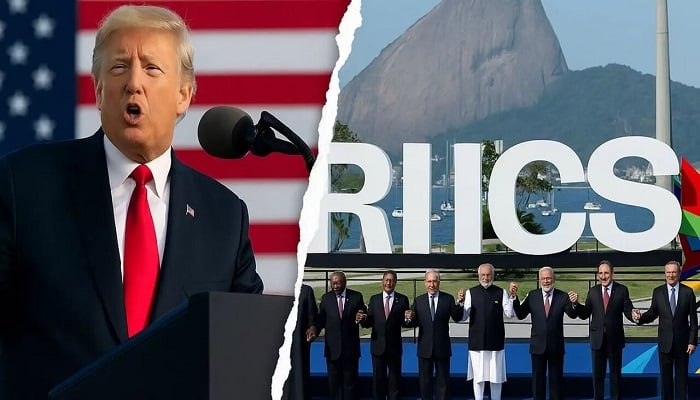PNN – Donald Trump’s threats against the BRICS group are actually a reflection of geopolitical fears about the shift in power in the international system; the BRICS group, once considered a symbolic alliance, has now become an indisputable economic bloc.
According to the report of Pakistan News Network, the emergence of the BRICS group as an economic and geopolitical alliance consisting of large and developing countries, including China, Russia, India, Brazil, and South Africa, has created a new challenge to the Western-led global economic order in recent years. The sustained economic growth of these countries and their efforts to gain independence from US-dominated structures have caused obvious concern for the US government, a concern that has been clearly reflected in the positions of US President Donald Trump, especially since the beginning of 2025.
The American magazine Politico believes that Western leaders have finally realized that the BRICS is no longer a symbolic gathering, but a real strategic threat to the US-dominated global order. This was even demonstrated at the 2025 summit in Brazil, where it became clear that these countries want to replace the current system and implement new rules for it.
BRICS emphasizes principles such as trade in national currencies, the creation of independent banks such as the New Development Bank (NDB), sustainable development, and economic integration, and one of its goals is to create financial infrastructures independent of the dollar and Western institutions.
Read more:
Trump’s economic war with the BRICS
Donald Trump has repeatedly targeted the BRICS with economic threats in recent months. A few days ago, he announced a 10% tariff on imports from the BRICS countries, calling it a response to the group’s “anti-American policies.” Trump said, “If they really come to fruition, they will end very quickly.”
He went on to promise that he would not allow any country or group to “play with America.” Trump also stated his opposition to the launch of any national or digital currency that might undermine the dollar’s position.
Sanctions on Russia: An indirect target of the attack on BRICS
According to Sputnik, one example of Trump’s belligerent approach against BRICS is the “Russia Sanctions Act 2025,” which includes imposing heavy secondary tariffs (between 100 and 500 percent) on countries that trade with Russia. Given that Russia is a major member of BRICS and a key trading partner of China, India, and Brazil, this law is in effect a direct threat to BRICS members.
However, the bill has yet to pass the Senate, and according to John Gang, a professor at the Beijing University of International Economics and Trade, “Ultimately, this will remain just an empty threat.”
Gang emphasizes that the BRICS countries will not succumb to US pressure and will continue to trade with Russia, because the US restrictions on Russian resources such as energy, fertilizer, and food do not have an effective alternative in the global market.
BRICS and the limitations of American tools
Analysts believe that the real US power to exert pressure on the BRICS is diminishing. Professor Alexis Habyarimana of the University of Johannesburg believes that the combination of economic warfare [with Russia] and military proxy warfare has so far failed… Trump has very limited leverage.
He also believes that countries like China, with a wide variety of trading partners, are able to continue economic growth even if they completely lose the US market. This feature has made the BRICS more resilient to Washington’s policies of pressure and threats.
Habyarimana describes Trump’s strategy as “self-destructive” because it not only unites America’s enemies, but also alienates some of Washington’s traditional partners.
BRICS economic growth: The real threat to the Western-centric order
In addition to political threats, economic data also show that BRICS has now become a real competitor to the West. According to the official TASS report, Maxim Oreshkin, deputy head of the Russian presidential administration, stated that in the 1990s, the G7 countries were twice as large as BRICS, but now the BRICS countries have surpassed the G7 in terms of GDP volume.
He added that China now ranks first among the world’s economies, India third and Russia fourth. These statistics show that the center of gravity of the global economy is no longer in the Western world, but has shifted to the global South – especially the BRICS.
Given current global trends, Donald Trump’s harsh and threatening stances against BRICS are actually a reflection of the West’s geopolitical fear of power shifts in the international system. The BRICS group, once considered a symbolic alliance, has now become a bloc of considerable economic power.
Trump’s attempt to contain BRICS has been accompanied not only by tariffs and sanctions but also by weakening global multilateral diplomacy. However, economic and political developments show that this approach has not yet been fruitful and could even lead to further US isolation.

